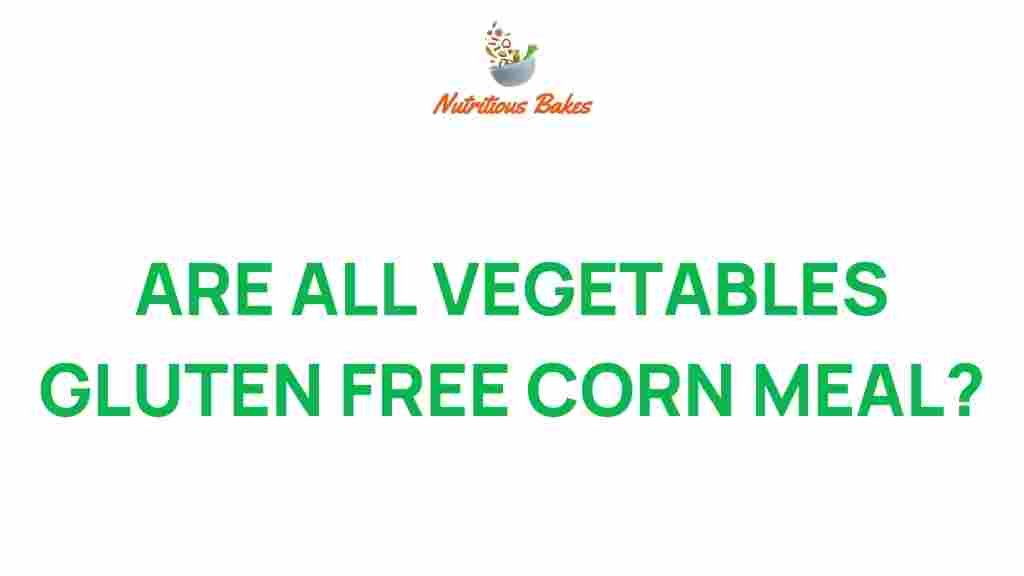Are All Vegetables Really Gluten-Free?
When it comes to dietary choices, the term “gluten-free” has gained significant traction in recent years. For individuals with gluten sensitivity or celiac disease, avoiding gluten is not just a trend but a necessity. However, many people often wonder if all vegetables are inherently gluten-free. This article aims to uncover the truth behind vegetables and gluten, exploring common misconceptions, health tips, and nutritional insights.
Understanding Gluten
Before diving into the gluten-free status of vegetables, let’s clarify what gluten is. Gluten is a protein found primarily in wheat, barley, and rye. It provides elasticity to dough and is responsible for the chewy texture of many baked goods. For those with gluten sensitivity, consuming gluten can lead to various health issues, including digestive problems, fatigue, and skin conditions.
Are Vegetables Gluten-Free?
Most vegetables are naturally gluten-free. This includes a wide variety of fresh produce such as:
- Leafy greens (spinach, kale, lettuce)
- Root vegetables (carrots, potatoes, beets)
- Cruciferous vegetables (broccoli, cauliflower, cabbage)
- Fruits (apples, oranges, berries)
However, there are exceptions and important considerations to keep in mind.
Processed Vegetables and Gluten
While fresh vegetables are gluten-free, processed vegetables may not be. When vegetables are canned, frozen, or prepared, they can be mixed with sauces or seasonings that contain gluten. For example:
- Vegetable soups with wheat-based thickeners
- Frozen vegetable mixes with gluten-containing sauces
- Pickled vegetables that use malt vinegar
Always check labels to ensure that these products are gluten-free.
Cross-Contamination: A Hidden Risk
Cross-contamination can occur when gluten-containing foods come into contact with gluten-free vegetables. This is particularly important in shared kitchens or restaurants. For those with gluten sensitivity, even a small amount of gluten can trigger symptoms.
To minimize the risk of cross-contamination, consider the following tips:
- Use separate cutting boards and utensils for gluten-free and gluten-containing foods.
- Wash vegetables thoroughly to remove any traces of gluten.
- Ask about food preparation methods when dining out.
Examining Corn Meal
Corn is a vegetable that is often a topic of debate in gluten-free diets. Corn meal, made from ground corn, is gluten-free. It is commonly used in various recipes, including cornbread and polenta. However, it’s essential to ensure that the corn meal is labeled gluten-free, as some brands may process corn in facilities that also handle gluten-containing grains.
Food Myths: Debunking Misconceptions
There are many food myths surrounding gluten and vegetables. Here are a few common misconceptions:
- All grains are gluten-free: While many grains like quinoa and rice are gluten-free, wheat, barley, and rye are not.
- Vegetables are safe to eat without checking: Always verify if processed vegetables contain gluten.
- Gluten-free diets are healthier: Gluten-free processed foods can be just as unhealthy as their gluten-containing counterparts.
Health Tips for a Gluten-Free Diet
Maintaining a gluten-free diet doesn’t have to be challenging. Here are some health tips to consider:
- Focus on whole foods: Emphasize fresh fruits, vegetables, lean proteins, and gluten-free grains like quinoa and rice.
- Stay informed: Educate yourself about gluten-containing ingredients and how to read food labels effectively.
- Plan meals: Meal planning can help you avoid impulsive choices that may not align with your dietary needs.
Cooking Gluten-Free Vegetables
Cooking gluten-free vegetables can be simple and delicious. Here are some steps to create flavorful gluten-free dishes:
- Select fresh vegetables: Choose a variety of colorful vegetables for a nutrient-rich meal.
- Wash and prepare: Properly wash vegetables to remove dirt and potential gluten traces. Chop them into desired sizes.
- Choose gluten-free cooking methods: Steam, roast, or stir-fry vegetables using gluten-free oils and seasonings.
- Add flavor: Use herbs, spices, and gluten-free sauces to enhance the taste of your dishes.
Conclusion
The truth behind the gluten-free status of vegetables is largely positive; most vegetables are naturally gluten-free. However, it’s crucial to be aware of processed foods, cross-contamination, and food myths. By making informed dietary choices and following health tips, you can enjoy a nutritious, gluten-free lifestyle.
For more information on gluten sensitivity and dietary choices, check out this comprehensive guide. If you want to explore gluten-free recipes, visit this recipe website for inspiration.
Remember, consulting with a healthcare professional or a registered dietitian can provide personalized advice tailored to your unique health needs and dietary preferences.
This article is in the category Diet and created by NutritiousBakes Team
